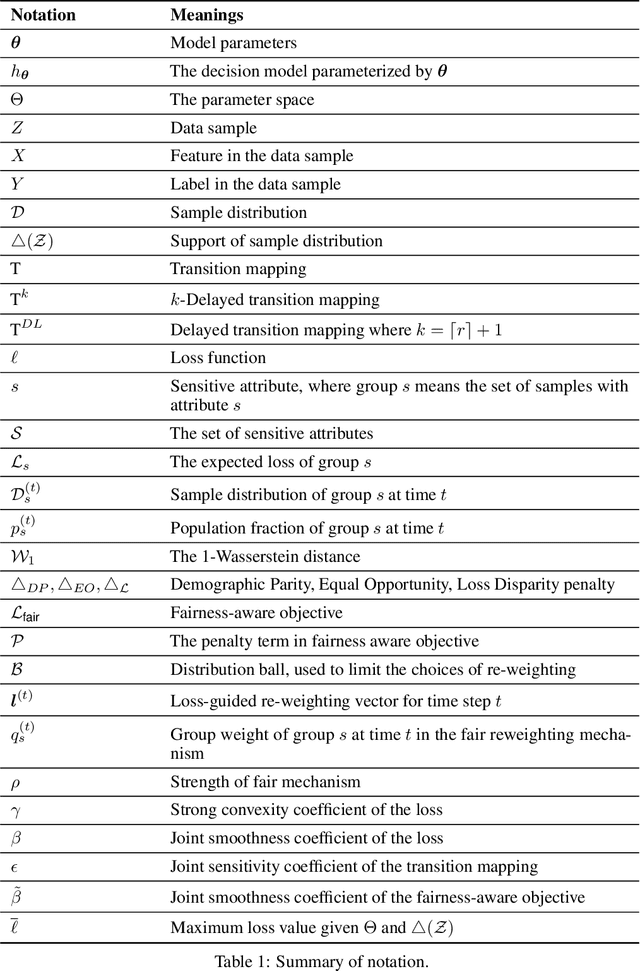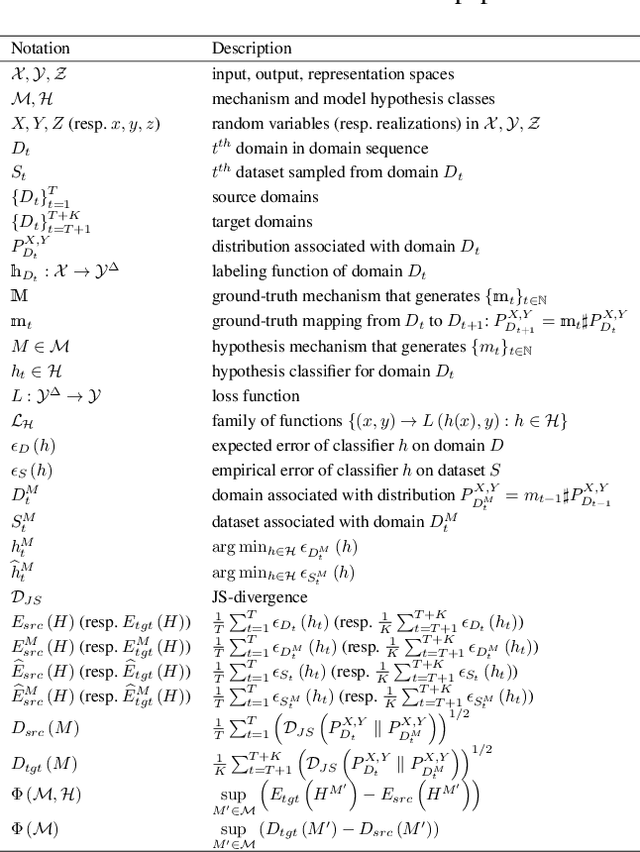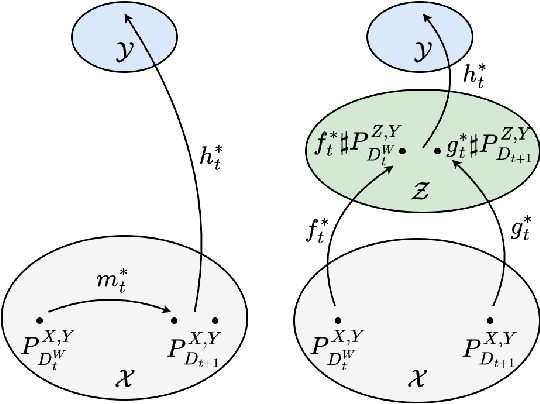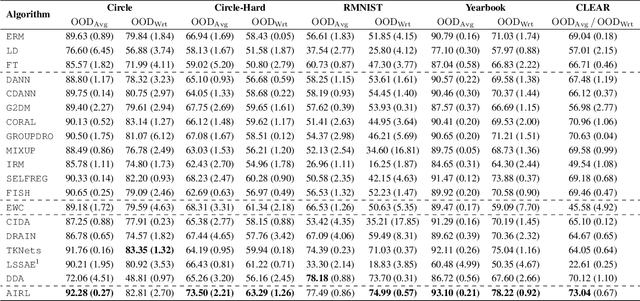Xueru Zhang
Self-Consuming Generative Models with Adversarially Curated Data
May 14, 2025Abstract:Recent advances in generative models have made it increasingly difficult to distinguish real data from model-generated synthetic data. Using synthetic data for successive training of future model generations creates "self-consuming loops", which may lead to model collapse or training instability. Furthermore, synthetic data is often subject to human feedback and curated by users based on their preferences. Ferbach et al. (2024) recently showed that when data is curated according to user preferences, the self-consuming retraining loop drives the model to converge toward a distribution that optimizes those preferences. However, in practice, data curation is often noisy or adversarially manipulated. For example, competing platforms may recruit malicious users to adversarially curate data and disrupt rival models. In this paper, we study how generative models evolve under self-consuming retraining loops with noisy and adversarially curated data. We theoretically analyze the impact of such noisy data curation on generative models and identify conditions for the robustness of the retraining process. Building on this analysis, we design attack algorithms for competitive adversarial scenarios, where a platform with a limited budget employs malicious users to misalign a rival's model from actual user preferences. Experiments on both synthetic and real-world datasets demonstrate the effectiveness of the proposed algorithms.
BiasCause: Evaluate Socially Biased Causal Reasoning of Large Language Models
Apr 08, 2025Abstract:While large language models (LLMs) already play significant roles in society, research has shown that LLMs still generate content including social bias against certain sensitive groups. While existing benchmarks have effectively identified social biases in LLMs, a critical gap remains in our understanding of the underlying reasoning that leads to these biased outputs. This paper goes one step further to evaluate the causal reasoning process of LLMs when they answer questions eliciting social biases. We first propose a novel conceptual framework to classify the causal reasoning produced by LLMs. Next, we use LLMs to synthesize $1788$ questions covering $8$ sensitive attributes and manually validate them. The questions can test different kinds of causal reasoning by letting LLMs disclose their reasoning process with causal graphs. We then test 4 state-of-the-art LLMs. All models answer the majority of questions with biased causal reasoning, resulting in a total of $4135$ biased causal graphs. Meanwhile, we discover $3$ strategies for LLMs to avoid biased causal reasoning by analyzing the "bias-free" cases. Finally, we reveal that LLMs are also prone to "mistaken-biased" causal reasoning, where they first confuse correlation with causality to infer specific sensitive group names and then incorporate biased causal reasoning.
DroughtSet: Understanding Drought Through Spatial-Temporal Learning
Dec 19, 2024Abstract:Drought is one of the most destructive and expensive natural disasters, severely impacting natural resources and risks by depleting water resources and diminishing agricultural yields. Under climate change, accurately predicting drought is critical for mitigating drought-induced risks. However, the intricate interplay among the physical and biological drivers that regulate droughts limits the predictability and understanding of drought, particularly at a subseasonal to seasonal (S2S) time scale. While deep learning has been demonstrated with potential in addressing climate forecasting challenges, its application to drought prediction has received relatively less attention. In this work, we propose a new dataset, DroughtSet, which integrates relevant predictive features and three drought indices from multiple remote sensing and reanalysis datasets across the contiguous United States (CONUS). DroughtSet specifically provides the machine learning community with a new real-world dataset to benchmark drought prediction models and more generally, time-series forecasting methods. Furthermore, we propose a spatial-temporal model SPDrought to predict and interpret S2S droughts. Our model learns from the spatial and temporal information of physical and biological features to predict three types of droughts simultaneously. Multiple strategies are employed to quantify the importance of physical and biological features for drought prediction. Our results provide insights for researchers to better understand the predictability and sensitivity of drought to biological and physical conditions. We aim to contribute to the climate field by proposing a new tool to predict and understand the occurrence of droughts and provide the AI community with a new benchmark to study deep learning applications in climate science.
Open-Set Heterogeneous Domain Adaptation: Theoretical Analysis and Algorithm
Dec 17, 2024Abstract:Domain adaptation (DA) tackles the issue of distribution shift by learning a model from a source domain that generalizes to a target domain. However, most existing DA methods are designed for scenarios where the source and target domain data lie within the same feature space, which limits their applicability in real-world situations. Recently, heterogeneous DA (HeDA) methods have been introduced to address the challenges posed by heterogeneous feature space between source and target domains. Despite their successes, current HeDA techniques fall short when there is a mismatch in both feature and label spaces. To address this, this paper explores a new DA scenario called open-set HeDA (OSHeDA). In OSHeDA, the model must not only handle heterogeneity in feature space but also identify samples belonging to novel classes. To tackle this challenge, we first develop a novel theoretical framework that constructs learning bounds for prediction error on target domain. Guided by this framework, we propose a new DA method called Representation Learning for OSHeDA (RL-OSHeDA). This method is designed to simultaneously transfer knowledge between heterogeneous data sources and identify novel classes. Experiments across text, image, and clinical data demonstrate the effectiveness of our algorithm. Model implementation is available at \url{https://github.com/pth1993/OSHeDA}.
Lookahead Counterfactual Fairness
Dec 02, 2024Abstract:As machine learning (ML) algorithms are used in applications that involve humans, concerns have arisen that these algorithms may be biased against certain social groups. \textit{Counterfactual fairness} (CF) is a fairness notion proposed in Kusner et al. (2017) that measures the unfairness of ML predictions; it requires that the prediction perceived by an individual in the real world has the same marginal distribution as it would be in a counterfactual world, in which the individual belongs to a different group. Although CF ensures fair ML predictions, it fails to consider the downstream effects of ML predictions on individuals. Since humans are strategic and often adapt their behaviors in response to the ML system, predictions that satisfy CF may not lead to a fair future outcome for the individuals. In this paper, we introduce \textit{lookahead counterfactual fairness} (LCF), a fairness notion accounting for the downstream effects of ML models which requires the individual \textit{future status} to be counterfactually fair. We theoretically identify conditions under which LCF can be satisfied and propose an algorithm based on the theorems. We also extend the concept to path-dependent fairness. Experiments on both synthetic and real data validate the proposed method.
ProFL: Performative Robust Optimal Federated Learning
Oct 23, 2024Abstract:Performative prediction (PP) is a framework that captures distribution shifts that occur during the training of machine learning models due to their deployment. As the trained model is used, its generated data could cause the model to evolve, leading to deviations from the original data distribution. The impact of such model-induced distribution shifts in the federated learning (FL) setup remains unexplored despite being increasingly likely to transpire in real-life use cases. Although Jin et al. (2024) recently extended PP to FL in a straightforward manner, the resulting model only converges to a performative stable point, which may be far from optimal. The methods in Izzo et al. (2021); Miller et al. (2021) can find a performative optimal point in centralized settings, but they require the performative risk to be convex and the training data to be noiseless, assumptions often violated in realistic FL systems. This paper overcomes all of these shortcomings and proposes Performative robust optimal Federated Learning (ProFL), an algorithm that finds performative optimal points in FL from noisy and contaminated data. We present the convergence analysis under the Polyak-Lojasiewicz condition, which applies to non-convex objectives. Extensive experiments on multiple datasets validate our proposed algorithms' efficiency.
Addressing Polarization and Unfairness in Performative Prediction
Jun 24, 2024



Abstract:When machine learning (ML) models are used in applications that involve humans (e.g., online recommendation, school admission, hiring, lending), the model itself may trigger changes in the distribution of targeted data it aims to predict. Performative prediction (PP) is a framework that explicitly considers such model-dependent distribution shifts when learning ML models. While significant efforts have been devoted to finding performative stable (PS) solutions in PP for system robustness, their societal implications are less explored and it is unclear whether PS solutions are aligned with social norms such as fairness. In this paper, we set out to examine the fairness property of PS solutions in performative prediction. We first show that PS solutions can incur severe polarization effects and group-wise loss disparity. Although existing fairness mechanisms commonly used in literature can help mitigate unfairness, they may fail and disrupt the stability under model-dependent distribution shifts. We thus propose novel fairness intervention mechanisms that can simultaneously achieve both stability and fairness in PP settings. Both theoretical analysis and experiments are provided to validate the proposed method.
Privacy-Aware Randomized Quantization via Linear Programming
Jun 01, 2024



Abstract:Differential privacy mechanisms such as the Gaussian or Laplace mechanism have been widely used in data analytics for preserving individual privacy. However, they are mostly designed for continuous outputs and are unsuitable for scenarios where discrete values are necessary. Although various quantization mechanisms were proposed recently to generate discrete outputs under differential privacy, the outcomes are either biased or have an inferior accuracy-privacy trade-off. In this paper, we propose a family of quantization mechanisms that is unbiased and differentially private. It has a high degree of freedom and we show that some existing mechanisms can be considered as special cases of ours. To find the optimal mechanism, we formulate a linear optimization that can be solved efficiently using linear programming tools. Experiments show that our proposed mechanism can attain a better privacy-accuracy trade-off compared to baselines.
Automating Data Annotation under Strategic Human Agents: Risks and Potential Solutions
May 12, 2024Abstract:As machine learning (ML) models are increasingly used in social domains to make consequential decisions about humans, they often have the power to reshape data distributions. Humans, as strategic agents, continuously adapt their behaviors in response to the learning system. As populations change dynamically, ML systems may need frequent updates to ensure high performance. However, acquiring high-quality human-annotated samples can be highly challenging and even infeasible in social domains. A common practice to address this issue is using the model itself to annotate unlabeled data samples. This paper investigates the long-term impacts when ML models are retrained with model-annotated samples when they incorporate human strategic responses. We first formalize the interactions between strategic agents and the model and then analyze how they evolve under such dynamic interactions. We find that agents are increasingly likely to receive positive decisions as the model gets retrained, whereas the proportion of agents with positive labels may decrease over time. We thus propose a refined retraining process to stabilize the dynamics. Last, we examine how algorithmic fairness can be affected by these retraining processes and find that enforcing common fairness constraints at every round may not benefit the disadvantaged group in the long run. Experiments on (semi-)synthetic and real data validate the theoretical findings.
Non-stationary Domain Generalization: Theory and Algorithm
May 10, 2024



Abstract:Although recent advances in machine learning have shown its success to learn from independent and identically distributed (IID) data, it is vulnerable to out-of-distribution (OOD) data in an open world. Domain generalization (DG) deals with such an issue and it aims to learn a model from multiple source domains that can be generalized to unseen target domains. Existing studies on DG have largely focused on stationary settings with homogeneous source domains. However, in many applications, domains may evolve along a specific direction (e.g., time, space). Without accounting for such non-stationary patterns, models trained with existing methods may fail to generalize on OOD data. In this paper, we study domain generalization in non-stationary environment. We first examine the impact of environmental non-stationarity on model performance and establish the theoretical upper bounds for the model error at target domains. Then, we propose a novel algorithm based on adaptive invariant representation learning, which leverages the non-stationary pattern to train a model that attains good performance on target domains. Experiments on both synthetic and real data validate the proposed algorithm.
 Add to Chrome
Add to Chrome Add to Firefox
Add to Firefox Add to Edge
Add to Edge